Katherine Driggs-Campbell
Trust-Aware Embodied Bayesian Persuasion for Mixed-Autonomy
Sep 18, 2025Abstract:Safe and efficient interaction between autonomous vehicles (AVs) and human-driven vehicles (HVs) is a critical challenge for future transportation systems. While game-theoretic models capture how AVs influence HVs, they often suffer from a long-term decay of influence and can be perceived as manipulative, eroding the human's trust. This can paradoxically lead to riskier human driving behavior over repeated interactions. In this paper, we address this challenge by proposing the Trust-Aware Embodied Bayesian Persuasion (TA-EBP) framework. Our work makes three key contributions: First, we apply Bayesian persuasion to model communication at traffic intersections, offering a transparent alternative to traditional game-theoretic models. Second, we introduce a trust parameter to the persuasion framework, deriving a theorem for the minimum trust level required for influence. Finally, we ground the abstract signals of Bayesian persuasion theory into a continuous, physically meaningful action space, deriving a second theorem for the optimal signal magnitude, realized as an AV's forward nudge. Additionally, we validate our framework in a mixed-autonomy traffic simulation, demonstrating that TA-EBP successfully persuades HVs to drive more cautiously, eliminating collisions and improving traffic flow compared to baselines that either ignore trust or lack communication. Our work provides a transparent and non-strategic framework for influence in human-robot interaction, enhancing both safety and efficiency.
In-Situ Soil-Property Estimation and Bayesian Mapping with a Simulated Compact Track Loader
Jul 30, 2025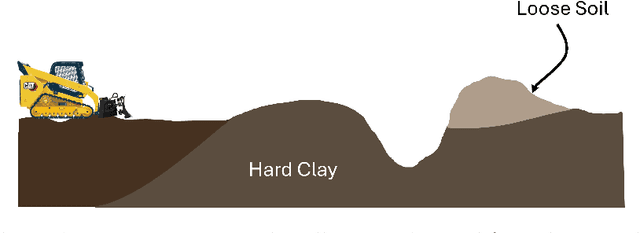
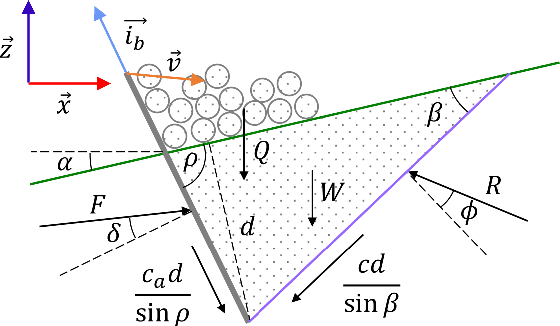
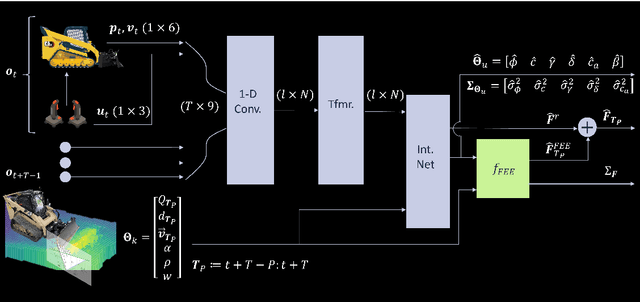
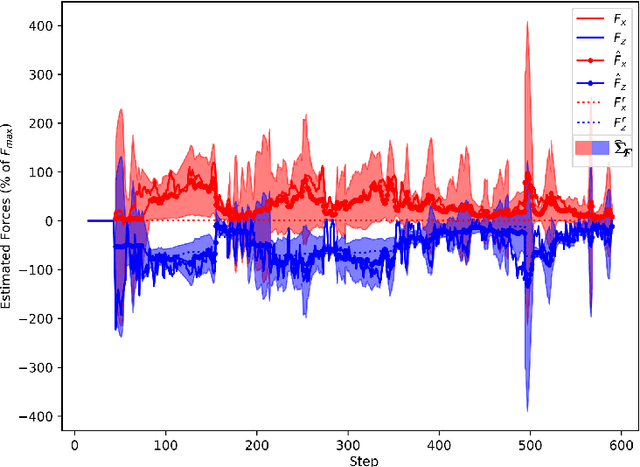
Abstract:Existing earthmoving autonomy is largely confined to highly controlled and well-characterized environments due to the complexity of vehicle-terrain interaction dynamics and the partial observability of the terrain resulting from unknown and spatially varying soil conditions. In this chapter, a a soil-property mapping system is proposed to extend the environmental state, in order to overcome these restrictions and facilitate development of more robust autonomous earthmoving. A GPU accelerated elevation mapping system is extended to incorporate a blind mapping component which traces the movement of the blade through the terrain to displace and erode intersected soil, enabling separately tracking undisturbed and disturbed soil. Each interaction is approximated as a flat blade moving through a locally homogeneous soil, enabling modeling of cutting forces using the fundamental equation of earthmoving (FEE). Building upon our prior work on in situ soil-property estimation, a method is devised to extract approximate geometric parameters of the model given the uneven terrain, and an improved physics infused neural network (PINN) model is developed to predict soil properties and uncertainties of these estimates. A simulation of a compact track loader (CTL) with a blade attachment is used to collect data to train the PINN model. Post-training, the model is leveraged online by the mapping system to track soil property estimates spatially as separate layers in the map, with updates being performed in a Bayesian manner. Initial experiments show that the system accurately highlights regions requiring higher relative interaction forces, indicating the promise of this approach in enabling soil-aware planning for autonomous terrain shaping.
Hierarchical Intention Tracking with Switching Trees for Real-Time Adaptation to Dynamic Human Intentions during Collaboration
Jun 08, 2025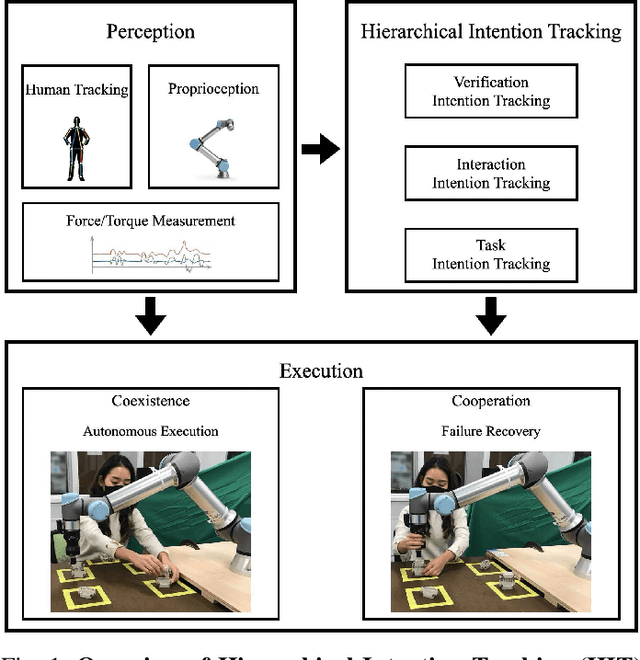
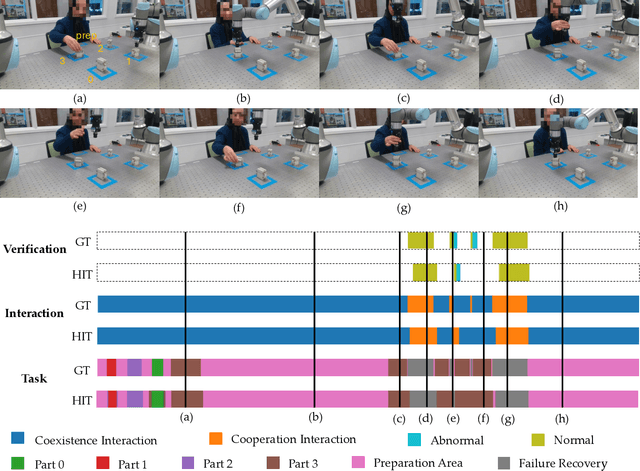
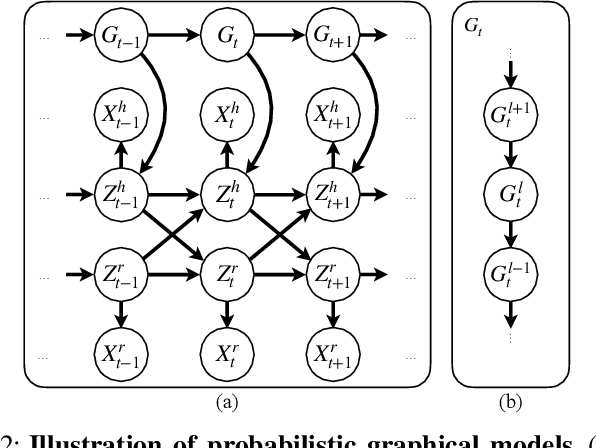

Abstract:During collaborative tasks, human behavior is guided by multiple levels of intentions that evolve over time, such as task sequence preferences and interaction strategies. To adapt to these changing preferences and promptly correct any inaccurate estimations, collaborative robots must accurately track these dynamic human intentions in real time. We propose a Hierarchical Intention Tracking (HIT) algorithm for collaborative robots to track dynamic and hierarchical human intentions effectively in real time. HIT represents human intentions as intention trees with arbitrary depth, and probabilistically tracks human intentions by Bayesian filtering, upward measurement propagation, and downward posterior propagation across all levels. We develop a HIT-based robotic system that dynamically switches between Interaction-Task and Verification-Task trees for a collaborative assembly task, allowing the robot to effectively coordinate human intentions at three levels: task-level (subtask goal locations), interaction-level (mode of engagement with the robot), and verification-level (confirming or correcting intention recognition). Our user study shows that our HIT-based collaborative robot system surpasses existing collaborative robot solutions by achieving a balance between efficiency, physical workload, and user comfort while ensuring safety and task completion. Post-experiment surveys further reveal that the HIT-based system enhances the user trust and minimizes interruptions to user's task flow through its effective understanding of human intentions across multiple levels.
Adaptive Stress Testing Black-Box LLM Planners
May 08, 2025Abstract:Large language models (LLMs) have recently demonstrated success in generalizing across decision-making tasks including planning, control and prediction, but their tendency to hallucinate unsafe and undesired outputs poses risks. We argue that detecting such failures is necessary, especially in safety-critical scenarios. Existing black-box methods often detect hallucinations by identifying inconsistencies across multiple samples. Many of these approaches typically introduce prompt perturbations like randomizing detail order or generating adversarial inputs, with the intuition that a confident model should produce stable outputs. We first perform a manual case study showing that other forms of perturbations (e.g., adding noise, removing sensor details) cause LLMs to hallucinate in a driving environment. We then propose a novel method for efficiently searching the space of prompt perturbations using Adaptive Stress Testing (AST) with Monte-Carlo Tree Search (MCTS). Our AST formulation enables discovery of scenarios and prompts that cause language models to act with high uncertainty. By generating MCTS prompt perturbation trees across diverse scenarios, we show that offline analyses can be used at runtime to automatically generate prompts that influence model uncertainty, and to inform real-time trust assessments of an LLM.
Do You Know the Way? Human-in-the-Loop Understanding for Fast Traversability Estimation in Mobile Robotics
Apr 28, 2025Abstract:The increasing use of robots in unstructured environments necessitates the development of effective perception and navigation strategies to enable field robots to successfully perform their tasks. In particular, it is key for such robots to understand where in their environment they can and cannot travel -- a task known as traversability estimation. However, existing geometric approaches to traversability estimation may fail to capture nuanced representations of traversability, whereas vision-based approaches typically either involve manually annotating a large number of images or require robot experience. In addition, existing methods can struggle to address domain shifts as they typically do not learn during deployment. To this end, we propose a human-in-the-loop (HiL) method for traversability estimation that prompts a human for annotations as-needed. Our method uses a foundation model to enable rapid learning on new annotations and to provide accurate predictions even when trained on a small number of quickly-provided HiL annotations. We extensively validate our method in simulation and on real-world data, and demonstrate that it can provide state-of-the-art traversability prediction performance.
Tool-as-Interface: Learning Robot Policies from Human Tool Usage through Imitation Learning
Apr 06, 2025Abstract:Tool use is critical for enabling robots to perform complex real-world tasks, and leveraging human tool-use data can be instrumental for teaching robots. However, existing data collection methods like teleoperation are slow, prone to control delays, and unsuitable for dynamic tasks. In contrast, human natural data, where humans directly perform tasks with tools, offers natural, unstructured interactions that are both efficient and easy to collect. Building on the insight that humans and robots can share the same tools, we propose a framework to transfer tool-use knowledge from human data to robots. Using two RGB cameras, our method generates 3D reconstruction, applies Gaussian splatting for novel view augmentation, employs segmentation models to extract embodiment-agnostic observations, and leverages task-space tool-action representations to train visuomotor policies. We validate our approach on diverse real-world tasks, including meatball scooping, pan flipping, wine bottle balancing, and other complex tasks. Our method achieves a 71\% higher average success rate compared to diffusion policies trained with teleoperation data and reduces data collection time by 77\%, with some tasks solvable only by our framework. Compared to hand-held gripper, our method cuts data collection time by 41\%. Additionally, our method bridges the embodiment gap, improves robustness to variations in camera viewpoints and robot configurations, and generalizes effectively across objects and spatial setups.
Learning Coordinated Bimanual Manipulation Policies using State Diffusion and Inverse Dynamics Models
Mar 30, 2025Abstract:When performing tasks like laundry, humans naturally coordinate both hands to manipulate objects and anticipate how their actions will change the state of the clothes. However, achieving such coordination in robotics remains challenging due to the need to model object movement, predict future states, and generate precise bimanual actions. In this work, we address these challenges by infusing the predictive nature of human manipulation strategies into robot imitation learning. Specifically, we disentangle task-related state transitions from agent-specific inverse dynamics modeling to enable effective bimanual coordination. Using a demonstration dataset, we train a diffusion model to predict future states given historical observations, envisioning how the scene evolves. Then, we use an inverse dynamics model to compute robot actions that achieve the predicted states. Our key insight is that modeling object movement can help learning policies for bimanual coordination manipulation tasks. Evaluating our framework across diverse simulation and real-world manipulation setups, including multimodal goal configurations, bimanual manipulation, deformable objects, and multi-object setups, we find that it consistently outperforms state-of-the-art state-to-action mapping policies. Our method demonstrates a remarkable capacity to navigate multimodal goal configurations and action distributions, maintain stability across different control modes, and synthesize a broader range of behaviors than those present in the demonstration dataset.
Towards Uncertainty Unification: A Case Study for Preference Learning
Mar 25, 2025



Abstract:Learning human preferences is essential for human-robot interaction, as it enables robots to adapt their behaviors to align with human expectations and goals. However, the inherent uncertainties in both human behavior and robotic systems make preference learning a challenging task. While probabilistic robotics algorithms offer uncertainty quantification, the integration of human preference uncertainty remains underexplored. To bridge this gap, we introduce uncertainty unification and propose a novel framework, uncertainty-unified preference learning (UUPL), which enhances Gaussian Process (GP)-based preference learning by unifying human and robot uncertainties. Specifically, UUPL includes a human preference uncertainty model that improves GP posterior mean estimation, and an uncertainty-weighted Gaussian Mixture Model (GMM) that enhances GP predictive variance accuracy. Additionally, we design a user-specific calibration process to align uncertainty representations across users, ensuring consistency and reliability in the model performance. Comprehensive experiments and user studies demonstrate that UUPL achieves state-of-the-art performance in both prediction accuracy and user rating. An ablation study further validates the effectiveness of human uncertainty model and uncertainty-weighted GMM of UUPL.
A Unified Framework for Robots that Influence Humans over Long-Term Interaction
Mar 18, 2025Abstract:Robot actions influence the decisions of nearby humans. Here influence refers to intentional change: robots influence humans when they shift the human's behavior in a way that helps the robot complete its task. Imagine an autonomous car trying to merge; by proactively nudging into the human's lane, the robot causes human drivers to yield and provide space. Influence is often necessary for seamless interaction. However, if influence is left unregulated and uncontrolled, robots will negatively impact the humans around them. Prior works have begun to address this problem by creating a variety of control algorithms that seek to influence humans. Although these methods are effective in the short-term, they fail to maintain influence over time as the human adapts to the robot's behaviors. In this paper we therefore present an optimization framework that enables robots to purposely regulate their influence over humans across both short-term and long-term interactions. Here the robot maintains its influence by reasoning over a dynamic human model which captures how the robot's current choices will impact the human's future behavior. Our resulting framework serves to unify current approaches: we demonstrate that state-of-the-art methods are simplifications of our underlying formalism. Our framework also provides a principled way to generate influential policies: in the best case the robot exactly solves our framework to find optimal, influential behavior. But when solving this optimization problem becomes impractical, designers can introduce their own simplifications to reach tractable approximations. We experimentally compare our unified framework to state-of-the-art baselines and ablations, and demonstrate across simulations and user studies that this framework is able to successfully influence humans over repeated interactions. See videos of our experiments here: https://youtu.be/nPekTUfUEbo
An Expert Ensemble for Detecting Anomalous Scenes, Interactions, and Behaviors in Autonomous Driving
Feb 23, 2025Abstract:As automated vehicles enter public roads, safety in a near-infinite number of driving scenarios becomes one of the major concerns for the widespread adoption of fully autonomous driving. The ability to detect anomalous situations outside of the operational design domain is a key component in self-driving cars, enabling us to mitigate the impact of abnormal ego behaviors and to realize trustworthy driving systems. On-road anomaly detection in egocentric videos remains a challenging problem due to the difficulties introduced by complex and interactive scenarios. We conduct a holistic analysis of common on-road anomaly patterns, from which we propose three unsupervised anomaly detection experts: a scene expert that focuses on frame-level appearances to detect abnormal scenes and unexpected scene motions; an interaction expert that models normal relative motions between two road participants and raises alarms whenever anomalous interactions emerge; and a behavior expert which monitors abnormal behaviors of individual objects by future trajectory prediction. To combine the strengths of all the modules, we propose an expert ensemble (Xen) using a Kalman filter, in which the final anomaly score is absorbed as one of the states and the observations are generated by the experts. Our experiments employ a novel evaluation protocol for realistic model performance, demonstrate superior anomaly detection performance than previous methods, and show that our framework has potential in classifying anomaly types using unsupervised learning on a large-scale on-road anomaly dataset.
 Add to Chrome
Add to Chrome Add to Firefox
Add to Firefox Add to Edge
Add to Edge